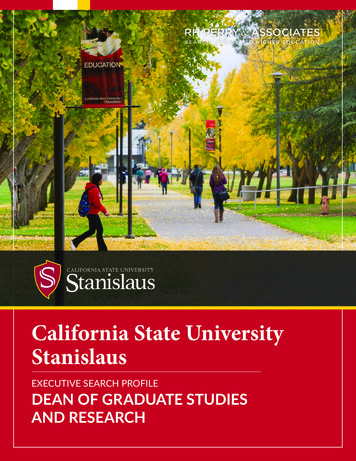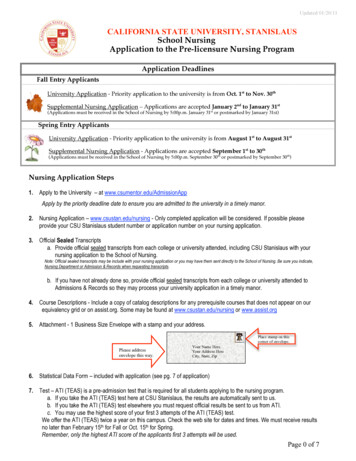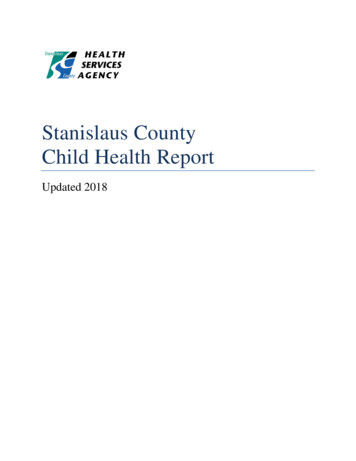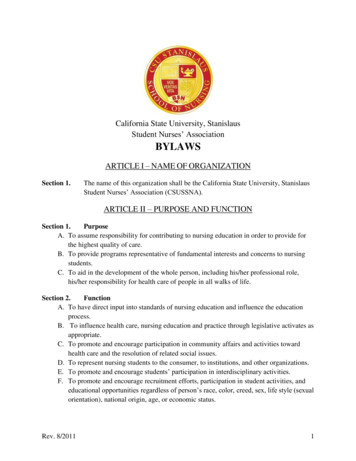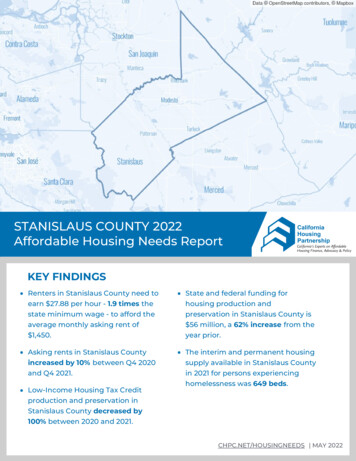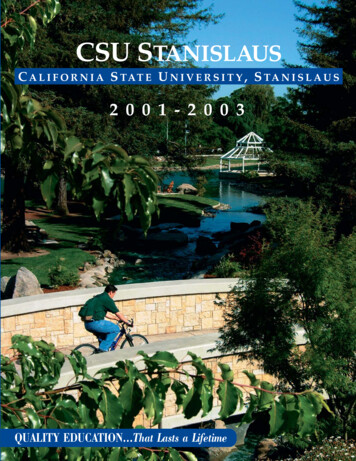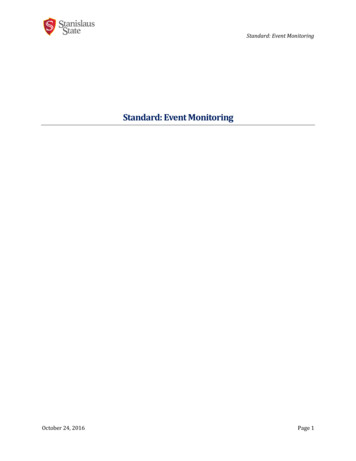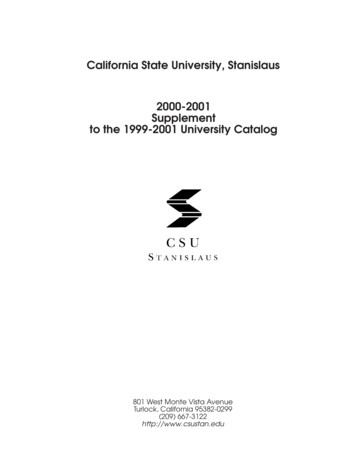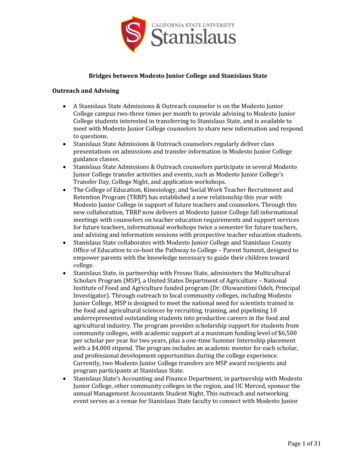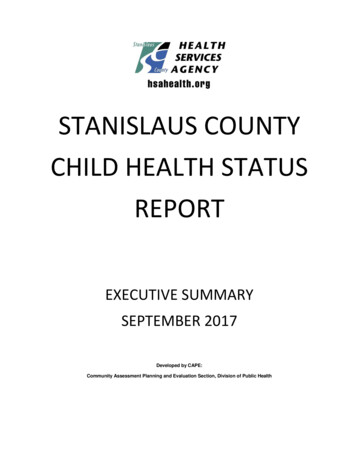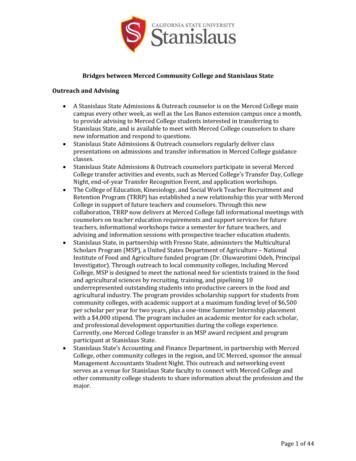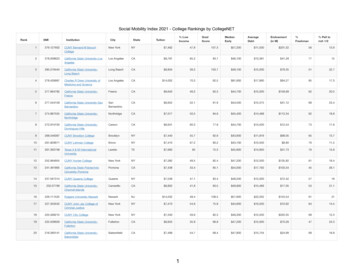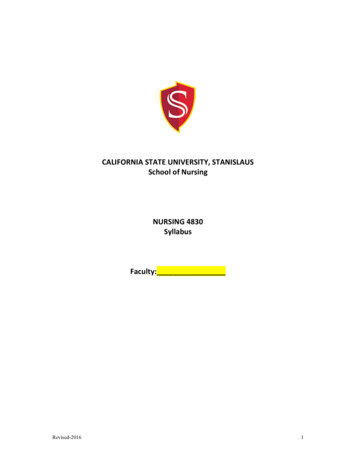
Transcription
CALIFORNIA STATE UNIVERSITY, STANISLAUSSchool of NursingNURSING 4830SyllabusFaculty:Revised-20161
COURSE OVERVIEWCOURSE NUMBER:COURSE TITLE:UNITS:NURS 4830Pre-Licensure Clinical Nursing Practicum4 Units (180 hours total). Travel time and lunches not includedin hours.6th Semester, Senior YearStudent-designed experience focusing on the role of theprofessional nurse in a variety of clinical practice settings.(Formerly NURS 4230) Prerequisites: Admission to the prelicensure nursing program and students must follow curricularroadmap for pre-licensure nursing and concurrent enrollment in4820.PLACEMENT IN CURRICULUM:CATALOG DESCRIPTION:COURSE OBJECTIVES (FOR CONTRACT): Upon completion of this course students will be able to:1. Integrate evidence, clinical judgment, interprofessional perspectives, and patient preferences inplanning, implementing, and evaluating outcomes of care across the lifespan.2. Apply leadership concepts, skills, and decision making in the provision of high quality nursing care,healthcare team coordination, and the oversight and accountability for care delivery in a variety ofsettings.3. Function effectively within nursing and intraprofessional teams, fostering open communication,mutual respect, negotiation, and shared decision making to achieve quality nursing care.4. Recognize the patient, family, or population as the source of control and full partner in providingcompassionate and coordinated care based on respect for human dignity, preferences, culture,and/or way of life.5. Describe inter- and intraprofessional mechanisms to resolve practice discrepancies, includingethical, unsafe, and/or illegal care practices.6. Participate in quality and patient safety initiatives, recognizing that there are complex systemsissues.7. Participate as a member of the profession, through advocacy, lifelong learning, and professionalinvolvement.TEXT:TOPICAL OUTLINE:TEACHING STRATEGIES:No text is required for this courseStudent-centered individual learning contract (See Website)Learning contract individualized for each clinical practicum.EVALUATION METHODS:Contract for clinical hoursPortfolioClinical experiencesGRADING SCALE:Revised-2016AAB BBC 94-100% 91-93% 88-90% 85-87% 82-84% 79-81%20%30%50%CCD DDFdue datedue datedue date 76-78% 73-75% 70-72% 67-69% 64-66% 63%2
Clinical Contract: 20% of gradeThe student is responsible for developing, in collaboration with their preceptor and faculty advisor, aclinical contract identifying activities that will enable the student to meet the course objectives. Eachobjective (from previous page) should have at least 2 activities associated with it. The followingtemplate can be adapted and individualized to meet the student’s learning needs. The Student LearningContract is due by week 3. Students may complete up to 2 clinical days with their preceptor prior tofinal approval of the contract. The completed contract with all signatures is due by week 4.The following is a short excerpt from a longer template that can be found on the web site. Download and adapt it for your own use!CALIFORNIA STATE UNIVERSITY, STANISLAUSSCHOOL OF NURSINGN4830 – ADVANCED CLINICAL NURSING PRACTICUM CONTRACT – TEMPLATEStudent Name:Clinical area:Agency Administrator:Preceptor:Student Phone:Agency:Agency Phone:Preceptor Phone:Faculty Advisor:Education:Beginning date:Faculty Phone:Date of Completion:RELEVANT EXPERIENCE: Previous 5 semesters (of 6 total) in CSU Stanislaus’ BSN nursing program.PURPOSE: To gain knowledge, skills, and attitudes surrounding quality (and safe) patient care, hospitalpolicy and protocol as it relates to the nurses’ role. To transition from student to new-graduate nurseroles.OBJECTIVES AND ACTIVITIES (EVIDENCE) DESCRIPTION: (bulleted examples are illustrative and shouldbe revised and individualized to reflect each student’s learning needs, with input from the preceptor)1. Integrate evidence, clinical judgment, interprofessional perspectives, and patient preferences inplanning, implementing, and evaluating outcomes of care across the lifespan.Create individualized patient care plans that incorporate patient preferences, evidencebased interventions, and evaluation of the care providedClinical Experiences: 50% of gradeStudents will meet with their clinical faculty on a weekly basis (in person, via blog/journal, by phone,and/or online using Internet conferencing tools) to discuss clinical experiences. Preceptors may beasked to complete the following rubric :Status for this weekClinical care of patientsProfessional ExcellentOther3
In addition, students will be responsible for maintaining a journal, or blog, of clinical experiences. Your4830 faculty will instruct you in their preference for online Bb discussions, online blogs, or somethingelse of their choosing. If your instructor prefers an online blog, you may create a free version athttp://wordpress.com and make it private; you permit others to view your blog via various settings andemail invitations. Detailed instructions for blogging will be posted on the Bb course site. Journals/blogsare to be submitted beginning in week 3, or whenever you begin your clinical hours with your preceptor.10 entries are expected during your clinical experiences with your preceptor, and you are also expectedto comment and reflect on entries your peers have posted. Journal entries are to be reflective of yourcontract and student learning objectives, and should demonstrate synthesis of learning and experience.The journal should include:1. Brief summary of clinical experience2. Analytic reflection specific to clinical experience and contract3. Literature verification as appropriateGrading rubric -- journal entries will be scored using the following rubric0 points2.5 pointsWriting QualityToo many errors; Noliterature supportA few errors; Minimalliterature supportReflective Thinking QualityLittle/no effort or thinkingincluded.Adequate reflective thinkingincluded.5 pointsNo errors; Adequate andappropriate literaturesupportExcellent reflective thinkingincludedPortfolio: 30% of gradeStudents are responsible for submitting a portfolio of their accomplishments throughout the nursingprogram as well as a brief description of how that assignment, activity, or experience helped the studentmeet one or more of the Student Learning Outcomes (SLO’s) listed below.The portfolio is a tool that demonstrates your progress in meeting individual, course, and program goals.Its purpose is to assess varied aspects of learning as it relates to the SLO’s. The portfolio containsexamples of your academic accomplishments as well as self-reflective statements that summarize whyyou selected the items for inclusion and what the items reveal about your learning (Palomba, 1999).Examples of the types of materials you might include in your portfolio.Concept maps and care plansScreen capture of technologies usedScholarly papersCertificates of CE completionPictures (with permission where needed)Skills checklistClinical evaluationsGroup projectsJournal or blog postings (with identifiers redacted)You will be expected to link the evidence you choose to include with the SLO’s. Explain why you includedeach item and elaborate on what the item demonstrates about your learning and how it helped youachieve that specific SLO. For example in addressing SLO #3 on critical thinking, you may decide toinclude a concept map on CHF that you completed in NURS 2910 and compare it with a concept map onCHF that you completed in NURS 4810 to demonstrate advancing knowledge.Revised-20164
Portfolio’s will be evaluated based on the following rubric:CriteriaUnacceptable - 0Adequate – 2.5Excellent - 5Organization and neatnessQuality of content and reflective statementsCompleteness of materials providedVariety and relevance of materialsAll student learning outcomes representedProfessional portfolio suitable for interviewingYOU MUST RESPECT PATIENT CONFIDENTIALITY IN ALL OF YOUR ENTRIES, RESPONSES, JOURNALS, PORTFOLIOS. PLEASE DONOT INCLUDE ANY IDENTIFYING INFORMATION INCLUDING BUT NOT LIMITED TO NAME OF AGENCY, UNIT, OR PATIENT.FAILURE TO RESPECT PATIENT CONFIDENTIALITY MAY RESULT IN COURSE FAILURE.Student Learning Outcomes (for Portfolio)1.2.Integrate the knowledge, theories and methods of a variety of disciplines to inform decision making.Participate in the process of inquiry, analysis, and information literacy to promote quality care and patientsafety.3. Apply leadership concepts, abilities, and decision making in the provision of high quality nursing care,healthcare team coordination, and the oversight and accountability for care delivery in a variety ofsettings.4. Integrate evidence, clinical judgment, inter-professional perspectives, and patient preferences inplanning, implementing, and evaluating outcomes of care.5. Demonstrate skills in using patient care technologies, information systems, and communication devicesthat support safe nursing practice6. Demonstrate basic knowledge of healthcare policy, finance, and regulatory environments, including local,state, national, and global healthcare trends.7. Use inter- and intra-professional communication and collaborative skills to deliver evidence-based,patient centered care.8. Assess health/illness beliefs, values, attitudes, and practices of individuals, families, groups, communitiesand populations in order to provide comprehensive care to diverse populations.9. Demonstrate the professional standards of moral, ethical, and legal conduct.10. Foster professional growth and development through the pursuit of lifelong learning and professionalengagement, towards an understanding of the ambiguity and unpredictability of the world and its effecton the healthcare system.11. Implement holistic, patient-centered care that reflects an understanding of human growth anddevelopment, pathophysiology, pharmacology, medical and nursing management across thehealth/illness continuum, across the lifespan, and in all healthcare settings.See all forms posted on web siteSample contractStudent and faculty evaluation of preceptorFaculty evaluation of studentBlog/journal examplesPortfolio excerpt examplesClinical hours logSample thank you letter to preceptorPolicy related to workplace injury procedureRevised-20165
Clinical Performance Evaluation2910Student FinalFacultyStudent1. Patient Centered CareValues and respects all patients/familyProtects patient privacy and confidentiality (verbally and documentation)Institues an individualized plan of care including assessment, planning, interventions,and evaluationDelivers care based on knowledge of pathophysiology and pharmacotherapy withrespect for individual values, preferences, needs, and diversity2. Teamwork and CollaborationPerforms effective verbal/nonverbal communication with patients, families, andhealthcare professionalsProduces clear, accurate, and relevant writing/chartingUses appropriate communication across the lifespanUses appropriate communication tools to convey relevant data to othermembers of the healthcare team3. Evidence Based PracticeIntegrates evidence based literature into the clinical practice to guide careFollows agency policies and procedures in providing safe, quality care.Uses core nursing knowledge in health promotion, prevention, pain/comfort, diseasemanagement, and patient/family teaching4. Quality ImprovementPromote cost containment methods in delivering careAwareness of quality improvement projects/processess within the facility, such ascore measures (AMI, Stroke)5. SafetyPerform nursing skills safely and accuratelyAdministers medication safely, accurately, and appropriately for the age anddiagnosis of the patientDiscusses relevant, accurate, and logical rationale for entire plan of careAcknowledges own limits and seeks appropriate resourcesActs as a client advocateMaintains a safe environment for the patient (actions do not increase patientexposure to harm)Ability to notice, interpret, respond, and reflect in all clinical experiencesRevised-20166Faculty
6. ProfessionalismDemonstrates core professional values (caring, altruism, integrity, human dignity,and social justice)Demonstrates accountability for own actions, including self reportingTakes responsibility to be informed and for own learning, including being fullyprepared for all clincial experiencesMaintains a positive attitude and interacts with patients and the interprofessionalteam in a professional and respectful mannerReports promptly to the clinical area for pre and post conference, notifies instructorof any absenceMaintains professional appearanceFollows the Code of Ethics for Nurses, the California Nurse Practice Act, and the ANAStandards of Clinical Nursing PracticeMidterm Evaluation:Strengths and areas for improvement:Student comments:Instructor:Student:Date:Final Evaluation:Strengths and areas for improvement:Student comments:Revised-20167
Instructor:Student:Date:Preceptor:Clinical Agency:Scoring:321N/AScoring Instructions:Exceeds ExpectationsMeets ExpectationsBelow ExpectationsNot ApplicableStudents and faculty will score performance both at midtermand at the end of the semester. Students may be at BelowExpectations at midterm without consequences. Final scoresmust be at least Meets Expectation at the end of thesemester in order to progress to the next semester.Students: Return completed form to your clinical faculty or preceptorPreceptor: Return completed form to the faculty memberFaculty: Return completed forms to the clinical coordinatorRevised-20168
Clinical Hour Log SheetDatePlacement SiteType of ActivityPt/ClientContact%Observation %ArriveLunchin andoutDepartWeek 1Week 2Week 3Week 4Week 5Week 6Week 7Week 8Week ours*
Week15*Total Clinical Hours does not include travel, lunch, or prep time*Total Clinical Hours includes PreLoad, Orientation, Computer training, Simulation daysBy signing I confirm these are true and accurate hours spent in clinical activities, as detailedabove.SignatureDatePreceptor Contact and Site Visits:Faculty will be contacting your preceptor BEFORE you begin your practicum hours. You willneed to communicate with your faculty regarding your start date and schedule.Faculty will be coming to your clinical sites 3 times over the semester (beginning, middle, andend) or more as needed.In between visits, faculty will be contacting your preceptor weekly via phone or email to ensurethere are no issues.Revised-201610
A. EMPLOYEE INFORMATIONName (Last, First):BargainingUnit:CityStreet (Home)Home NumberCell NumberCampus DivisionAASAJob TitleShift TimeUABFFA/HR------Date of Birth:StateZip CodeSex:MaleFemaleSupervisor NameDepartmentFTPTStudent in Field WorkWork DaysSuMTWAMPMAMPMB. INJURY/ILLNESS INFORMATIONDate of Injury/Illness:Time of Injury/Illness:Date you were informed of injury/illness:Extension:SATHDate of Hire:Supervisor ExtensionVolunteer/Seasonal (Attach Volunteer Authorization Form)FSaSpecific Location of Injury/Incident occurred (on/off campus):Name of Witness(s)/ Phone#:Date you gave employee “Workers’ Compensation Claim Form (DWC1)” including Notice of Potential Eligibility:Indicate Nature of Specific injury/illness (cut, sprain, foreign body, burn, carpal tunnel); part of body affected and please circle all injured areas:LeftWere other employees injured in this event? YesWere non-employees injured in this incident? YesNoNoWas there any property damage during this incident? YesRightLeftRight(If yes, complete a separate report for each employee)(If yes, University Police should be contacted to prepare a report: (209) 667-3114)NoIf yes, describe the property damage:Did this employee injury/illness occur during the course of the employee’s normally assigned duties? YesNoWhat was employee doing just before the incident occurred? Fully explain sequence of events that resulted in injury/illness. Describe the activity aswell as the tools, equipment, or material the employee was using. Be specific. Examples:” materials”, “spraying chlorine from hand sprayer”; “dailycomputer key-entry”:Describe what happened. How did the injury or illness occur? Describe the actions, conditions, and decisions that led to the incident. Examples:“When ladder slipped on wet floor, worker fell 20 feet”; Worker was sprayed with chlorine when gasket broke”; developed soreness in wrist overtime.”Describe work place and conditions which contributed to the accident or object or substance that directly harmed employee. Was Personal ProtectiveEquipment (PPE) in use?Revised-201611
What object or substance directly harmed the employee? Examples: “concrete floor; “chlorine”’ radial arm saw.”Were proper procedures being followed when the incident occurred? YesNoIf no, explainDoes a written safe work practice for the task that was underway at the time of the incident exist? YesNoWas current, documented employee training provided for the task/procedure/equipment prior incident? YesNoWhat corrective action or preventative action was taken to prevent recurrence? Check as many as appropriate.Safety Guidelines DevelopedEmployee CounseledSafety Training ScheduledRepairs Ordered/MadePersonal Protective Equipment OrderedOther (attach separate page if necessary)C. MEDICAL TREATMENT INFORMATIONDid injury result in disability beyond day of accident?YesNoIf “Yes”, date last worked:Date returned to work:If employee died, when did death occur?Medical Treatment by:Medical Treatment DeclinedSutter Gould (Turlock/Modesto)Treated SelfOtherPersonal PhysicianSt. Josephs (Stockton)Emergency RoomPre-Designated Physician: (must have pre-designated physician form on file prior to injury)Employee was transported by ambulance to: Hospital: Phone Number:Employee was hospitalized overnight as an in-patientName/Address of Treating Physician:Phone Number:CALIFORNIA STATE UNIVERSITY, STANISLAUSFaculty Affairs and Human Resources, MSR340 One University Circle Turlock, CA 95382 Phone (209) 667-3392 Fax (209) 6646536ADMINISTRATIVE USE:OSHARecord OnlyWC Claim#To be completed by Supervisor/Manager for all injuries/illnesses to employees including student assistants, volunteers, andpart time employees. Fill out ALL information below and return to the Workers’ Compensation Coordinator, MSR340. Provideemployee “Workers’ Compensation Claim Form (DWC1)” including Notice of Potential Eligibility immediately upon knowledge ofinjury or illness.Complete this form in its entirety and submit within 24-hours of the injuryManager/Supervisor Signature:Revised-2016Date:12
WC Coordinator/HR Rep Signature:Date:Distribution: Return to FA/HR: (1) Fax to (209) 664-6536; (2) Hand deliver to FA/HR, MSR340; (3) Mail interoffice in a sealed confidentialenvelope; (4) Keep department copy on fileRevised-201613
The following is a short excerpt from a longer template that can be found on the web site. Download and adapt it for your own use! CALIFORNIA STATE UNIVERSITY, STANISLAUS SCHOOL OF NURSING N4830 - ADVANCED CLINICAL NURSING PRACTICUM CONTRACT - TEMPLATE Student Name: Student Phone: Clinical area: Agency:
